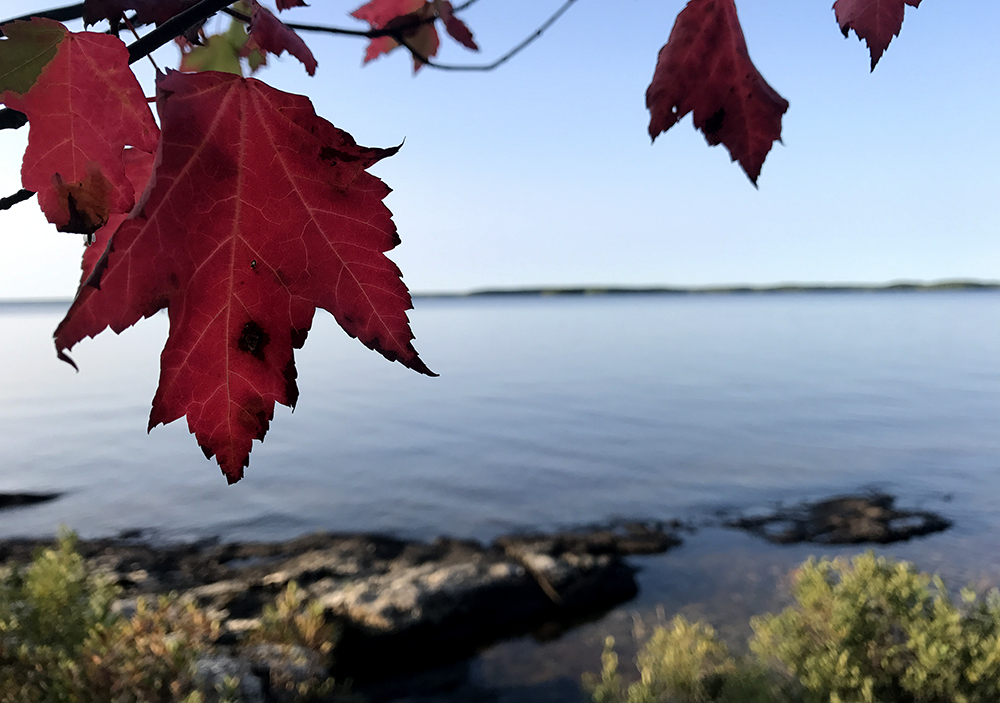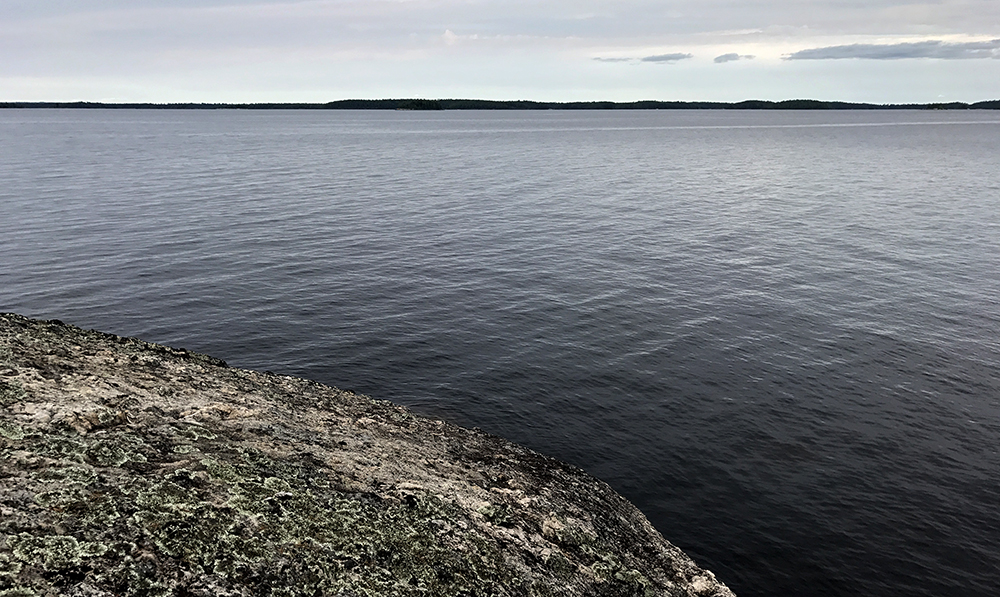Minnesota is affectionately termed “The Land of 10,000 Lakes”. So it seems appropriate that a national park here should consist of several such bodies of water. Voyageurs National Park holds 30 separate lakes. This in addition to more than 900 islands and a remote North Woods peninsula that offers waterborne visitors complete solitude.

Guide to Voyageurs
Voyageurs National Park
Voyageurs National Park is a boater’s dream; a watery wonderland in which watercraft is necessary in order to merely enter its thickly wooded wilderness. Vast forests separate waterways that not long ago served as vital arteries of access for the French-Canadian Voyageurs, from whom the park takes its name.
Nearly 40 percent of the 218,000 acres that make up Voyageurs is covered by water. There are four major lakes – Kabetogama, Namakan, Rainy and Sand Point along with the smaller Crane Lake and Black Bay, which lie to the east and west, respectively.
These large lakes are separated by the massive Kabetogama Peninsula, which stretches east-to-west across the center of the park and is penetrated by narrow bays and waterways, along with hundreds of smaller lakes which allow boaters access to cross-park travel through scenes nearly identical to those observed by the Voyageurs of centuries past.
Exploring Voyageurs
As may be clear by this point, Voyageurs is a wilderness of lakes and islands, with a mere 8 miles of roadway available for landlubbers. Largely a backcountry park, there is little offered to those who arrive without a boat, although rental services are available in surrounding communities. There are also boat tours available for a fee. See the activities page for more information regarding rentals and tours.
The backcountry however, offers splendid tranquility in quiet forests strewn with more than 270 backcountry campsites where weary boaters take to the shore for evenings around the warmth of a small inviting campfire. Campers here enjoy solitude, and indeed, travelers can fish for their dinner on the shore of their own private island, if only for a night or two. Backcountry permits are required and can be arranged online. See the activities page for more info.

For those with little interest in water-based activities, there are options on the land, but few. A couple of trails lead along the shoreline of the mainland. These trails can be used in summer, and can also be accessed with snowshoe or cross-country skis during the winter season.
Speaking of the winter season, the area becomes a mecca for snowmobile exploration, and there are a great number of trails that lead through portage areas, and on frozen lakes.
Playtime
The park holds endless miles for paddlers with more than 655 miles of shoreline, although offerings are limited for hiking. The park’s longest trail is the Cruiser Lake Trail, which winds for just over 10 miles through lush forests while linking Kabatogama Lake’s Lost Bay to Anderson Bay on the southern shores of Rainy Lake, with Cruiser Lake sitting inland at about the half way point on the trail.
Private watercraft are prohibited on inland lakes that are not part of marked waterways. However, the park service has provided canoes at many remote lakes that can be accessed by trail once guests have made their way to the Kabetogama Peninsula via private or rented watercraft. These canoes are locked at docks at such locations, and combinations for the locks will be given upon receipt of the permit which authorizes use. Permits can be obtained through recreation.gov.

The park welcomes paddlers and motorized boats as well. Many choose to enjoy the scenery of Voyageurs from the comfort of a houseboat, which, along with smaller watercraft, can be rented in the marinas of neighboring communities. Visitors should be aware that the adjacent Boundary Waters Canoe Area Wilderness in Superior National Forest prohibits motorized watercraft. See the activities page for more information.
Services in Voyageurs
The only accommodation provided inside the park is the Kettle Falls Hotel, which sits on the U.S. – Canadian border and has been in operation since 1918. This remote hotel offers basic rooms, or for those who desire a bit more comfort, villas and suites. The hotel is only accessible by boat or seaplane. Boat rentals are available at the hotel, which is closed in winters. Shuttle service is available. See the visiting page for more info.
There is are no restaurants inside the park, aside from at Kettle Falls. Neither will visitors find car camping available inside the park, however, campgrounds can be found nearby in Wooden Frog State Forest and at Ash River. Several hotels are found in small communities around the park. See the visiting page for more info.
The park has three visitor centers, Rainy Lake, Kabetogama Lake, and Ash River. Each location shows the park orientation film, and have information desks. There are hiking trails near these visitor centers, but they are short and offer only a brief view of the park. The NPS offers a variety of tours in the summer months, such as the North Canoe voyage, which departs from each visitor center and puts guests on the lake in a 26-foot canoe.
Wildlife
Voyageurs is home to a great number of creatures that you won’t want searching for food in your camp. Given this, campsites in the park provide bear boxes, which should always be used. North Woods residents such as black bear, gray wolves and moose wonder about the Kabetogama, and they are hungry.
Beaver are aplenty, as it appears the Voyageurs woodsmen did not get them all. Bald eagles, double crested cormorants, owls and warblers scan the landscape from above. Often, the soothing sounds of loons and the distant howl of wolves offer lullabies as well-fed campers drift into dreamland in cozy tents.
The Voyageurs
As early as 1688, French-Canadian fur trappers such as Jacques de Noyon had established trading agreements with native tribes such as the Cree, Monsoni, Assiniboin and later, the Ojibway.

Public Domain Image*
Known for their intense stamina and ability to consistently paddle their long birch-bark canoes for 16 hours per day while singing boisterous songs about their adventurous lives, these rugged “Voyageur” woodsmen roamed this area throughout 18th and 19th centuries in search of beaver, whose valuable pelts were exported to wealthy cities in the eastern American colonies and Europe.
The trade-route-waterways that they mapped became so important to early travelers that in 1783 it was incorporated as a 55-mile-long section of the boundary between the United States and Canada.
Park Junkie Verdict
I have enjoyed both of my trips to Voyageurs. This place is a vast wilderness that offers absolute solitude in the park’s backcountry recesses. I took my own kayak both times, although my first trip was in an inflatable, which severely limited my mobility. Nevertheless, I was able to get to a camp, and hiked the Cruiser Lake Trail, which seemed to be my best bet, given the fact that my kayak was a bit unstable with all the gear needed for backcountry camping.
My second trip involved a real kayak, and I paddled from Ash River to the Kettle Falls Hotel, just to check it out. I took three days to make the round trip journey, and ate fresh fish for every meal. What a dream…
So, if you are considering a trip to Voyageurs, it may be clear by this point that you’ll want a boat, or to arrange a rental. You’ll probably also want to bring your fishing gear, and grab a Minnesota fishing license which may very well enable a feast of walleye, perch or northern pike from your comfortable campsite. See the visiting page for a list of boat rental services.
Sunsets here are vivid and the soft sound and rich scent of a crackling fire cooking a days catch along the smooth rocks of a polished Voyageurs shoreline often provides the perfect end to a long day on the water.
I can’t wait to get back up there and try a voyage through a few of the inland lakes!
See ya there…
Guide to Voyageurs
Relevant Links
National Park Guides

All content found on Park Junkie is meant solely for entertainment purposes and is the copyrighted property of Park Junkie Productions. Unauthorized reproduction is prohibited without the express written consent of Park Junkie Productions.
YOU CAN DIE. Activities pursued within National Park boundaries hold inherent dangers. You are solely responsible for your safety in the outdoors. Park Junkie accepts no responsibility for actions that result in inconveniences, injury or death.
This site is not affiliated with the National Park Service, or any particular park.
